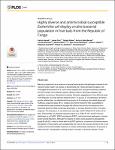Highly diverse and antimicrobial susceptible Escherichia coli display a naïve bacterial population in fruit bats from the Republic of Congo
Nowak, Kathrin
Fahr, Jakob
Weber, Natalie
Lübke-Becker, Antina
Semmler, Torsten
Weiss, Sabrina
Mombouli, Jean-Vivien
Wieler, Lothar H.
Guenther, Sebastian
Leendertz, Fabian H.
Ewers, Christa
Bats are suspected to be a reservoir of several bacterial and viral pathogens relevant to animal and human health, but studies on Escherichia coli in these animals are sparse. We investigated the presence of E. coli in tissue samples (liver, lung and intestines) collected from 50 fruit bats of five different species (Eidolon helvum, Epomops franqueti, Hypsignathus monstrosus, Myonycteris torquata, Rousettus aegyptiacus) of two different areas in the Republic of Congo between 2009 and 2010. To assess E. coli pathotypes and phylogenetic relationships, we determined the presence of 59 virulence associated genes and multilocus sequence types (STs). Isolates were further tested for their susceptibility to several antimicrobial substances by agar disk diffusion test and for the presence of an Extended-Spectrum Beta-Lactamase phenotype. E. coli was detected in 60% of the bats analysed. The diversity of E. coli strains was very high, with 37 different STs within 40 isolates. Occasionally, we detected sequence types (e.g. ST69, ST127, and ST131) and pathotypes (e.g. ExPEC, EPEC and atypical EPEC), which are known pathogens in human and/or animal infections. Although the majority of strains were assigned to phylogenetic group B2 (46.2%), which is linked with the ExPEC pathovar, occurrence of virulence-associated genes in these strains were unexpectedly low. Due to this, and as only few of the E. coli isolates showed intermediate resistance to certain antimicrobial substances, we assume a rather naïve E. coli population, lacking contact to humans or domestic animals. Future studies featuring in depth comparative whole genome sequence analyses will provide insights into the microevolution of this interesting strain collection.
No license information

